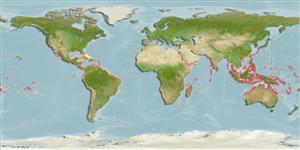Environment: milieu / climate zone / depth range / distribution range
Ecologia
marino associati a barriera corallina; non migratori; distribuzione batimetrica 1 - 5 m (Ref. 7247). Tropical; 30°N - 30°S
Indo-Pacific: Red Sea and East African coast to the Line and Society Islands, north to the Ryukyu and Bonin Islands, south to New Caledonia and Tonga; throughout Micronesia.
Size / Peso / Age
Maturity: Lm ? range ? - ? cm
Max length : 13.0 cm SL maschio/sesso non determinato; (Ref. 7247)
Spine dorsali (totale) : 12; Raggi dorsali molli (totale) : 14 - 16; Spine anali: 2; Raggi anali molli: 12 - 14.
A territorial species commonly found in coral reef areas with dead staghorn corals. Adults feed on filamentous algae supported by these dead corals. Frequently charge human intruders without hesitation, sometimes taking painful nips which are mildly alarming when unexpected. Particularly aggressive during reproductive periods. They emit a clicking noise during aggressive encounters. Act aggressively toward most herbivorous fishes and some other fishes; defend its territory for feeding advantages (Ref. 47011). Oviparous, distinct pairing during breeding (Ref. 205). Eggs are demersal and adhere to the substrate (Ref. 205). Males guard and aerate the eggs (Ref. 205).
Life cycle and mating behavior
Maturità | Riproduzione | Deposizione | Uova | Fecundity | Larve
Oviparous, distinct pairing during breeding (Ref. 205). Eggs are demersal and adhere to the substrate (Ref. 205). Males guard and aerate the eggs (Ref. 205).
Allen, G.R. and A.R. Emery, 1985. A review of the Pomacentrid fishes of the genus Stegastes from the Indo-Pacific, with descriptions of two new species. Indo-Pac. Fish. (3):31. (Ref. 510)
IUCN Red List Status (Ref. 130435: Version 2024-2)
Human uses
Pesca: scarso interesse commerciale
Strumenti
Special reports
Download XML
Fonti Internet
Estimates based on models
Preferred temperature (Ref.
123201): 25.5 - 29.3, mean 28.2 °C (based on 3835 cells).
Phylogenetic diversity index (Ref.
82804): PD
50 = 0.5000 [Uniqueness, from 0.5 = low to 2.0 = high].
Bayesian length-weight: a=0.02344 (0.01401 - 0.03921), b=2.96 (2.82 - 3.10), in cm total length, based on LWR estimates for this species & Genus-body shape (Ref.
93245).
Trophic level (Ref.
69278): 2.0 ±0.0 se; based on diet studies.
Resilienza (Ref.
120179): Alto, tempo minimo di raddoppiamento della popolazione meno di 15 mesi (Preliminary K or Fecundity.).
Fishing Vulnerability (Ref.
59153): Low vulnerability (10 of 100).
Nutrients (Ref.
124155): Calcium = 110 [53, 187] mg/100g; Iron = 0.749 [0.436, 1.329] mg/100g; Protein = 18 [17, 19] %; Omega3 = 0.0853 [, ] g/100g; Selenium = 17.6 [9.1, 37.6] μg/100g; VitaminA = 82.6 [19.0, 332.3] μg/100g; Zinc = 2.05 [1.33, 3.17] mg/100g (wet weight);
